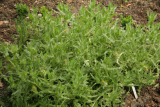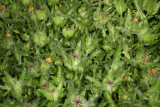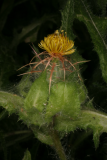Additional notes (click to expand)
Medicinal
Culpeper writes of it: ‘Carduus Benedictus. In plain English Blessed Thistle, though I confess it be better known by the Latin name. It ... helps swimming and giddiness in the head, deafness, strengthens the memory, helps griping pains in the belly, kills worms, provokes sweats, expels poison, helps inflammation of the liver, is very good in pestilences and the French Pox. Outwardly applied, it ripens plague sores, and helps hot swellings, the bitings of mad dogs, and venomous beasts and foul filthy ulcers. Everyone that can but make a Carduus posset [= a hot milk drink with added alcohol] knows how to use it.’
Culpeper, N. (1649). A Physicall Directory, or, a translation of the London Dispensatory made by the Colledge of Physicians.... London, Peter Cole/EEBO Proquest facsimile.
It is not an English plant, so it is surprising that it was apparently so well known. It has been investigated for anti-cancer activity. It was introduced to South Africa 150 years ago where it is used in ‘muthi’ medicine for diabetes and arthritis, loss of appetite and indigestion. It contains a bitter lactone, cnicin, which stimulates gastric acid production (van Wyk, 2000).
Van Wyk, B.E., Van Oudtshoorn, B Gericke, N. (2000). Medicinal Plants of South Africa, Briza Publications. 2nd ed
Traditional Herbal Medicine Registration (THMR).
Nomenclature
Synonym of Centaurea benedicta
Plants of the World online, Kew Science http://www.plantsoftheworldonline.org/taxon/urn:lsid:ipni.org:names:190024-1
link
Other use
The blessed thistle was widely cultivated in the middle ages, when it was seen as a cure-all for all manner of diseases including the plague. Although less widely used nowadays, it is still seen to have a wide range of applications though it is mainly employed as an ingredient in herbal tonics.
Geographical distribution
- Africa, Northern Africa, Algeria
- Africa, Northern Africa, Egypt
- Africa, Northern Africa, Libya
- Asia-Temperate, Caucasus, Transcaucasus
- Asia-Temperate, China
- Asia-Temperate, Middle Asia, Kazakhstan
- Asia-Temperate, Middle Asia, Kyrgyzstan
- Asia-Temperate, Middle Asia, Tadzhikistan
- Asia-Temperate, Middle Asia, Turkmenistan
- Asia-Temperate, Middle Asia, Uzbekistan
- Asia-Temperate, Western Asia, Afghanistan
- Asia-Temperate, Western Asia, Cyprus
- Asia-Temperate, Western Asia, Iran
- Asia-Temperate, Western Asia, Iraq
- Asia-Temperate, Western Asia, Israel
- Asia-Temperate, Western Asia, Jordan
- Asia-Temperate, Western Asia, Lebanon-Syria
- Asia-Temperate, Western Asia, Turkey
- Asia-Tropical, Indian Subcontinent, Pakistan
- Europe, Southeastern Europe, Albania
- Europe, Southeastern Europe, Bosnia and Herzegovina
- Europe, Southeastern Europe, Bulgaria
- Europe, Southeastern Europe, Greece
- Europe, Southeastern Europe, Italy
- Europe, Southeastern Europe, Yugoslavia
- Europe, Southwestern Europe, France
- Europe, Southwestern Europe, Portugal
- Europe, Southwestern Europe, Spain
Cnicus benedictus L.
Family: ASTERACEAEGenus: Cnicus
Species: benedictus L.
Common names: Bitter Thistle; Blessed Thistle
Pharmacopoeia Londinensis name: Carduus benedictus
Distribution summary: Eurasia
Habit: Annual
Hardiness: H3 - Half hardy; unheated greenhouse/mild winter
Habitat: Sunny, dry, rocky hills
Garden status: Not currently grown
Flowering months: May, June, July, August, September
Reason for growing: Medicinal, traditional herbal registration



